Everything is on schedule: how monitoring user activity on the main Mail.Ru helps to live and solve problems
The graph of user activity on the main page of Mail.Ru is a kind of thermometer, moreover, it is ultra-sensitive. At times, audience metrics reflect the problems that another large Internet service has encountered, or show a reaction to any important events in public life.
I will talk about how we use user activity monitoring to solve problems, as well as about its other applications that we found in this article.
For how the main page works, we follow the technical charts:
But often we see that user behavior changes dramatically, while there are no deviations on the technical graphs. To have a complete picture of what is happening on the main page, we supplemented them with graphs of user activity. They show transitions from the main page to other projects. We separately monitor both the "big" main and mobile (we have three mobile versions - for different phone models). As a bonus, we got a kind of thermometer of user interest in various topics and events.
Sudden changes in activity graphs almost always mean one of the following:
Practice shows that a sharp increase in user activity on a project most often does not indicate a sudden outbreak of users' love for the service, but, unfortunately, some problems have arisen. It’s just not always a problem on our side. I will talk about the most memorable cases to me.
One late evening, we saw that on the graphs suddenly began some kind of abnormal increase in activity for this time of day. Views of all versions of the main page, both large and mobile, have grown. We rushed to find out what was the matter. The graph of page refreshes, JS errors, load times and others showed standard data, there were no deviations. As a result, it turned out that the surge in activity was a consequence of the football match that had ended at that moment, which was important for the Russian team. People massively went online to discuss this event (conversions in social networks grew) and to look for more detailed information about it (conversions in search and news grew). Now we are quickly distinguishing such events from technical difficulties, as we see not only an increase in the number of page views, but also an increased interest in certain projects.
In the described situation, the graphs look like this: the growth of page views corresponds to the growth of transitions to the Mail.Ru News project. The graphs below show the increased user activity triggered by another landmark match: Russia - USA at the World Championships 2013 (May 16, 2013). This is + 10% to views of the main page and + 50% to transitions to the News.

Sporting events are the most predictable in time and cause a steady interest among users. Last year was especially rich in them. At the beginning of the year, we regularly observed surges in user activity graphs - these were numerous victories and rare defeats at the Olympics, world championships in hockey and football. By the way, according to our graphs, we can even determine which event caused the greatest resonance. So, for example, during the World Cup, the most interesting match for Russians was the Algeria-Russia match. Knowing that immediately after the end of such an event, people begin to behave more actively on the Internet (search for information, read news, etc.), we began to meet “heated” fans with holiday logos in case of victory in major competitions.
Another factor that can have a significant impact on user activity is television stories. There are things that look so massive that it is noticeable on our graphs! For example, when the broadcast began closing the Olympics, we immediately saw how people "left" the Internet - decreased views and activity. But at the time of the commercial break, the number of views of the mobile home page increased by 30-40%.
By correlating classroom schedules and the program of events, we began to make assumptions about which subjects are most and least interesting to users. For example, the most interesting moments for the viewers to close the Olympics were the beginning and end of the show - numbers with children and symbols of the Olympics.
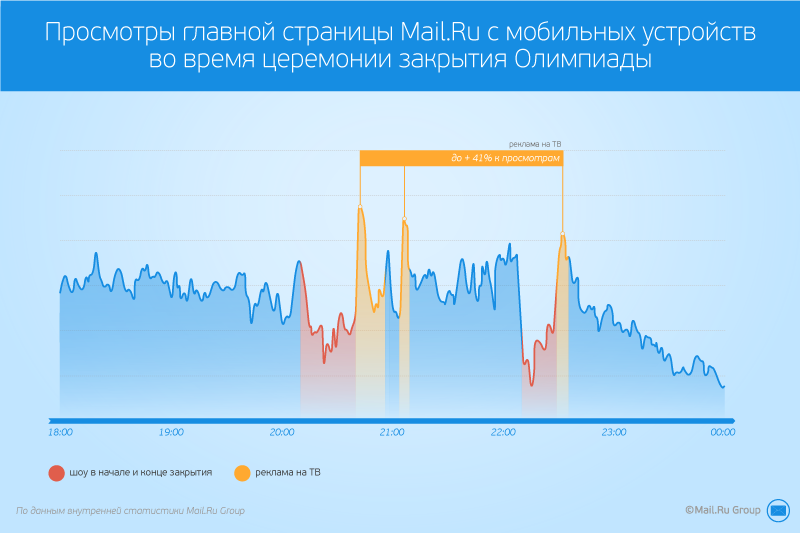
Another television story that steadily attracts the attention of a mass of users is the annual message and press conference of the president. On our charts, at this time, a decrease in attendance relative to the usual level is visible - people are more distracted by TV than usual. By the way, partly because of such a high interest, we began to show broadcasts of such events directly on the News.Ru news project.
Major incidents (the death of famous people, disasters, etc.) often cause bursts on the charts, comparable to sports events. The murder of Boris Nemtsov, which became known last Saturday February 28, is so resonant that the appearance of the first information about the incident not only caused a noticeable increase in conversions to the news and an increase in the number of search queries, but also reflected a surge in the views of the main page: despite the late time, people went online for details. This is especially noticeable on the mobile version of the home page.
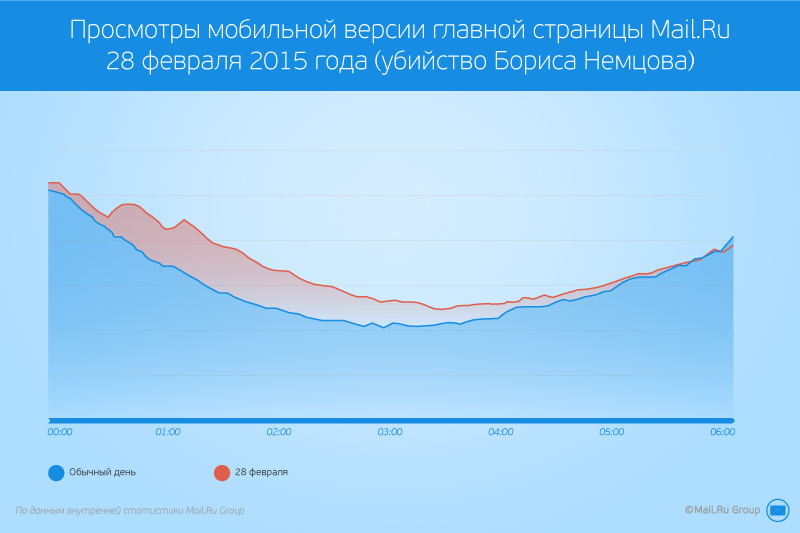
Our colleagues have prepared a special project about the events that have most interested people in recent years - Recent History of Russia 2006-2014 . Many of these events resulted in surges in user activity graphs. For instance,car accident that occurred in Kazan in 2013. The incident happened around eight in the evening, news on the topic appeared very soon. And, as expected, there was a huge interest in the incident:
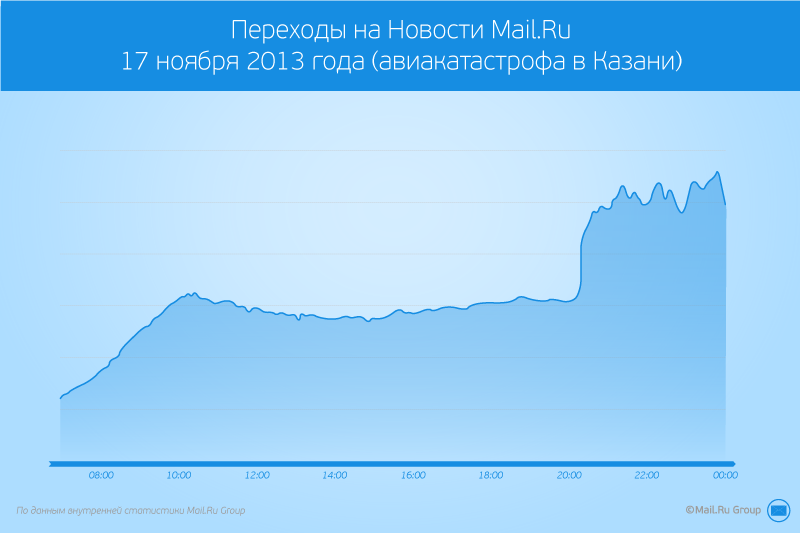
Finally, a great deal of resonance among users caused economic shocks. For example, interest in blocks with exchange rates on the main systematic grew during the fall of 2014 and peaked on December 16, when the Central Bank raised its key rate to 17%. However, as the value of the euro rose to 100 rubles on the MICEX exchange, the number of views on the Mail.Ru home page increased, from which users switched to the block with exchange rates. As a result, conversions to exchange rates increased 9 times compared to a normal day.
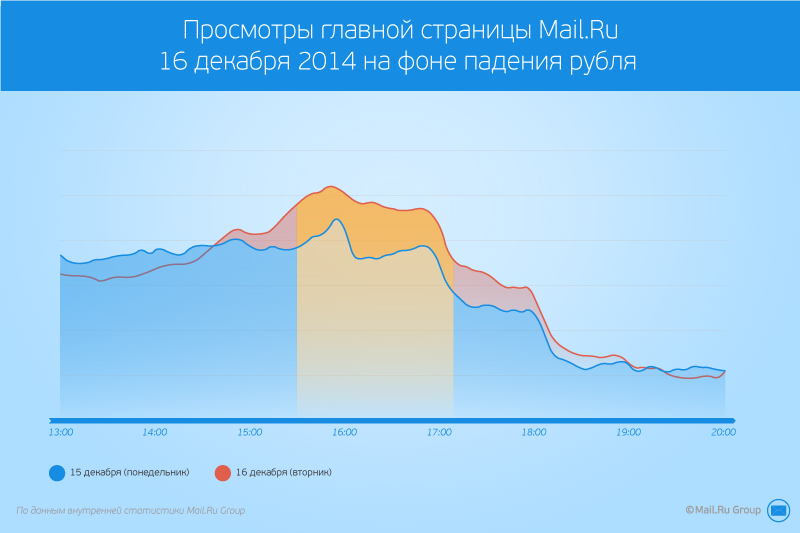
The schedule of transitions to Mail.Ru News from the main page allows us to distinguish such a natural increase in activity from bursts caused by other reasons, which will be discussed later. I generally read the news on the charts - if a splash is visible on them, then something noticeable has happened and it is worth reading the news on the main Mail.Ru.
It is interesting that other large Internet projects also influence the behavior of users of the Mail.Ru portal. Any, even a large and very reliable service, sometimes has technical problems (such accidents, as a rule, happen only several times a year), and user behavior at that moment looks interesting. You can see how people literally run from one resource to another.
The growth of transitions from the main page to several Mail.Ru projects simultaneously, as a rule, means that the user has problems accessing some other major service - a social network or a search engine. If you encounter problems with other search services on the main page, users are noticeably added and the number of search queries is growing. If social networks experience technical difficulties, people start looking for something to entertain themselves, and seem to go to all projects in general - to Mail, Search, News, download Agent, etc.
Another interesting case is access problems at a large provider. In Russia, there were no serious problems in my memory, but in Kazakhstan, where a noticeable percentage of the Mail.Ru audience lives, sometimes it happens. Here you need to add that the main page has three mobile versions: the touch version for iOS, Android and WP, the mobile version for users with Opera Mini browser, and the version for feature phones - weak phones and phones with a small screen. The geography of users differs between versions, so on the touch version there is a bias towards users from Moscow, and on the version for feature phones there are noticeably more, including users from Kazakhstan. Due to this difference, the problems in Kazakhstan can be guessed by the stronger deviations in the charts of the version for feature phones. In this example, the audience of this version sagged more noticeably in attendance,
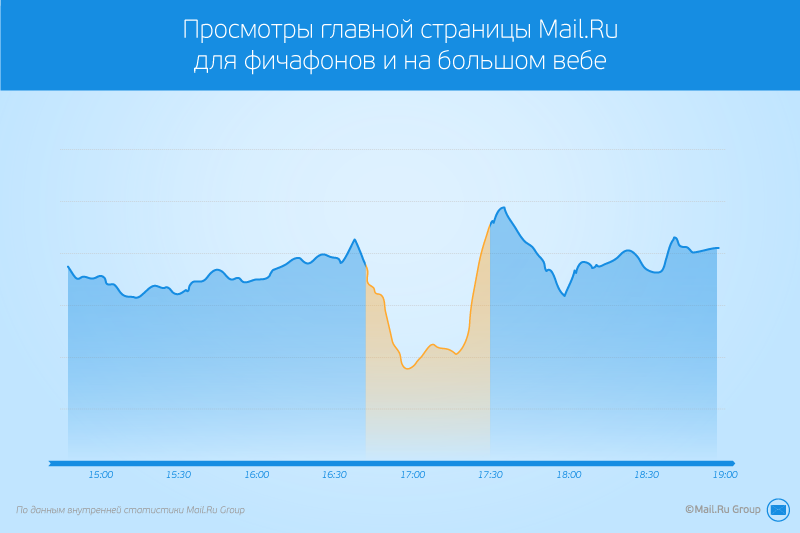
The availability of transition schedules for projects from the main page allows, inter alia, to quickly distinguish our technical problems from strangers. Without them, we would constantly twitch, trying to figure out the reasons, and just one look at the dashboard, which combines all the charts, to decide whether to take action.
In conclusion, I will give an example of how we tracked the problem on our side according to the charts. As in previous cases, at first we saw an increase in views and refreshes of the main page. User activity graphs made it possible to quickly determine where the problem was, as the transitions to the weather and the change of the city on the main one increased. It turned out that when automatically updating the geobase, part of the IP addresses was mistakenly assigned the wrong city. Users instantly reacted to this by clicking on the change of region in order to return “their” city to the main one. Thanks to this, we quickly noticed and fixed the error, and later covered this place with additional tests.
***
Examples of interesting user behavior, of course, are much more. We have collected and classified the most typical situations for the main page. The addition of technical graphs with graphs of user activity in the case of the main page allows you to quickly and accurately understand the reasons for the sharp change in user behavior. This reduces the time for troubleshooting or provides an understanding that there is no problem on the project side. In addition, activity graphs allow you to see which topics most concern people, and take this into account in the future.
Do you have experience systematically monitoring audience activity? Share interesting facts!
By the way, we are looking for a person who will help us develop the main page of Mail.Ru. If you are interested in such tasks, here is a link to our vacancy:brainstorage.me/jobs/27333
I will talk about how we use user activity monitoring to solve problems, as well as about its other applications that we found in this article.
For how the main page works, we follow the technical charts:
- The graph of the page load time by blocks. We look not only at the total loading time of the main page, but also at indicators for individual key blocks - Mail, News, etc.
- The schedule of "refreshes" (loading a page from the cache). It allows you to distinguish audience growth for natural reasons from page reloads by the same users. The second often says that users are faced with some kind of technical problem.
But often we see that user behavior changes dramatically, while there are no deviations on the technical graphs. To have a complete picture of what is happening on the main page, we supplemented them with graphs of user activity. They show transitions from the main page to other projects. We separately monitor both the "big" main and mobile (we have three mobile versions - for different phone models). As a bonus, we got a kind of thermometer of user interest in various topics and events.
Sudden changes in activity graphs almost always mean one of the following:
- an event exciting a large number of people (for example, large sporting events, emergencies, etc.);
- technical problems on other large or closely related Mail.Ru services;
- technical problems on the Mail.Ru main page itself (this happens really rarely, but just the presence of such monitoring allows you to distinguish problems on the main from problems on other major services).
Practice shows that a sharp increase in user activity on a project most often does not indicate a sudden outbreak of users' love for the service, but, unfortunately, some problems have arisen. It’s just not always a problem on our side. I will talk about the most memorable cases to me.
Exciting people events
One late evening, we saw that on the graphs suddenly began some kind of abnormal increase in activity for this time of day. Views of all versions of the main page, both large and mobile, have grown. We rushed to find out what was the matter. The graph of page refreshes, JS errors, load times and others showed standard data, there were no deviations. As a result, it turned out that the surge in activity was a consequence of the football match that had ended at that moment, which was important for the Russian team. People massively went online to discuss this event (conversions in social networks grew) and to look for more detailed information about it (conversions in search and news grew). Now we are quickly distinguishing such events from technical difficulties, as we see not only an increase in the number of page views, but also an increased interest in certain projects.
In the described situation, the graphs look like this: the growth of page views corresponds to the growth of transitions to the Mail.Ru News project. The graphs below show the increased user activity triggered by another landmark match: Russia - USA at the World Championships 2013 (May 16, 2013). This is + 10% to views of the main page and + 50% to transitions to the News.

Sporting events are the most predictable in time and cause a steady interest among users. Last year was especially rich in them. At the beginning of the year, we regularly observed surges in user activity graphs - these were numerous victories and rare defeats at the Olympics, world championships in hockey and football. By the way, according to our graphs, we can even determine which event caused the greatest resonance. So, for example, during the World Cup, the most interesting match for Russians was the Algeria-Russia match. Knowing that immediately after the end of such an event, people begin to behave more actively on the Internet (search for information, read news, etc.), we began to meet “heated” fans with holiday logos in case of victory in major competitions.
Another factor that can have a significant impact on user activity is television stories. There are things that look so massive that it is noticeable on our graphs! For example, when the broadcast began closing the Olympics, we immediately saw how people "left" the Internet - decreased views and activity. But at the time of the commercial break, the number of views of the mobile home page increased by 30-40%.
By correlating classroom schedules and the program of events, we began to make assumptions about which subjects are most and least interesting to users. For example, the most interesting moments for the viewers to close the Olympics were the beginning and end of the show - numbers with children and symbols of the Olympics.

Another television story that steadily attracts the attention of a mass of users is the annual message and press conference of the president. On our charts, at this time, a decrease in attendance relative to the usual level is visible - people are more distracted by TV than usual. By the way, partly because of such a high interest, we began to show broadcasts of such events directly on the News.Ru news project.
Major incidents (the death of famous people, disasters, etc.) often cause bursts on the charts, comparable to sports events. The murder of Boris Nemtsov, which became known last Saturday February 28, is so resonant that the appearance of the first information about the incident not only caused a noticeable increase in conversions to the news and an increase in the number of search queries, but also reflected a surge in the views of the main page: despite the late time, people went online for details. This is especially noticeable on the mobile version of the home page.

Our colleagues have prepared a special project about the events that have most interested people in recent years - Recent History of Russia 2006-2014 . Many of these events resulted in surges in user activity graphs. For instance,car accident that occurred in Kazan in 2013. The incident happened around eight in the evening, news on the topic appeared very soon. And, as expected, there was a huge interest in the incident:

Finally, a great deal of resonance among users caused economic shocks. For example, interest in blocks with exchange rates on the main systematic grew during the fall of 2014 and peaked on December 16, when the Central Bank raised its key rate to 17%. However, as the value of the euro rose to 100 rubles on the MICEX exchange, the number of views on the Mail.Ru home page increased, from which users switched to the block with exchange rates. As a result, conversions to exchange rates increased 9 times compared to a normal day.

The schedule of transitions to Mail.Ru News from the main page allows us to distinguish such a natural increase in activity from bursts caused by other reasons, which will be discussed later. I generally read the news on the charts - if a splash is visible on them, then something noticeable has happened and it is worth reading the news on the main Mail.Ru.
Changes to other major Internet projects
It is interesting that other large Internet projects also influence the behavior of users of the Mail.Ru portal. Any, even a large and very reliable service, sometimes has technical problems (such accidents, as a rule, happen only several times a year), and user behavior at that moment looks interesting. You can see how people literally run from one resource to another.
The growth of transitions from the main page to several Mail.Ru projects simultaneously, as a rule, means that the user has problems accessing some other major service - a social network or a search engine. If you encounter problems with other search services on the main page, users are noticeably added and the number of search queries is growing. If social networks experience technical difficulties, people start looking for something to entertain themselves, and seem to go to all projects in general - to Mail, Search, News, download Agent, etc.
Problems with a major Internet service provider
Another interesting case is access problems at a large provider. In Russia, there were no serious problems in my memory, but in Kazakhstan, where a noticeable percentage of the Mail.Ru audience lives, sometimes it happens. Here you need to add that the main page has three mobile versions: the touch version for iOS, Android and WP, the mobile version for users with Opera Mini browser, and the version for feature phones - weak phones and phones with a small screen. The geography of users differs between versions, so on the touch version there is a bias towards users from Moscow, and on the version for feature phones there are noticeably more, including users from Kazakhstan. Due to this difference, the problems in Kazakhstan can be guessed by the stronger deviations in the charts of the version for feature phones. In this example, the audience of this version sagged more noticeably in attendance,

The availability of transition schedules for projects from the main page allows, inter alia, to quickly distinguish our technical problems from strangers. Without them, we would constantly twitch, trying to figure out the reasons, and just one look at the dashboard, which combines all the charts, to decide whether to take action.
Technical problems on the main page
In conclusion, I will give an example of how we tracked the problem on our side according to the charts. As in previous cases, at first we saw an increase in views and refreshes of the main page. User activity graphs made it possible to quickly determine where the problem was, as the transitions to the weather and the change of the city on the main one increased. It turned out that when automatically updating the geobase, part of the IP addresses was mistakenly assigned the wrong city. Users instantly reacted to this by clicking on the change of region in order to return “their” city to the main one. Thanks to this, we quickly noticed and fixed the error, and later covered this place with additional tests.
***
Examples of interesting user behavior, of course, are much more. We have collected and classified the most typical situations for the main page. The addition of technical graphs with graphs of user activity in the case of the main page allows you to quickly and accurately understand the reasons for the sharp change in user behavior. This reduces the time for troubleshooting or provides an understanding that there is no problem on the project side. In addition, activity graphs allow you to see which topics most concern people, and take this into account in the future.
Do you have experience systematically monitoring audience activity? Share interesting facts!
By the way, we are looking for a person who will help us develop the main page of Mail.Ru. If you are interested in such tasks, here is a link to our vacancy:brainstorage.me/jobs/27333
